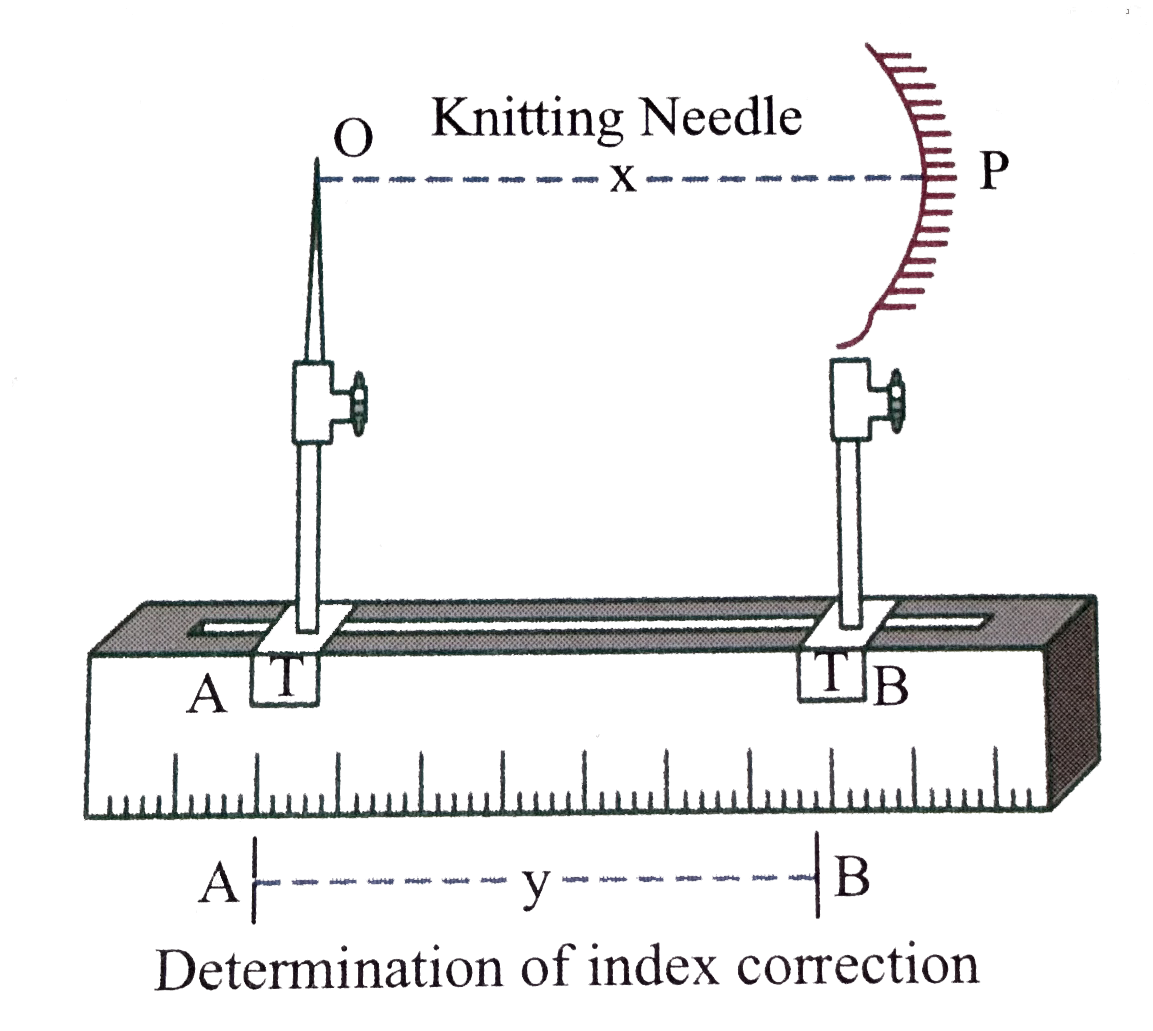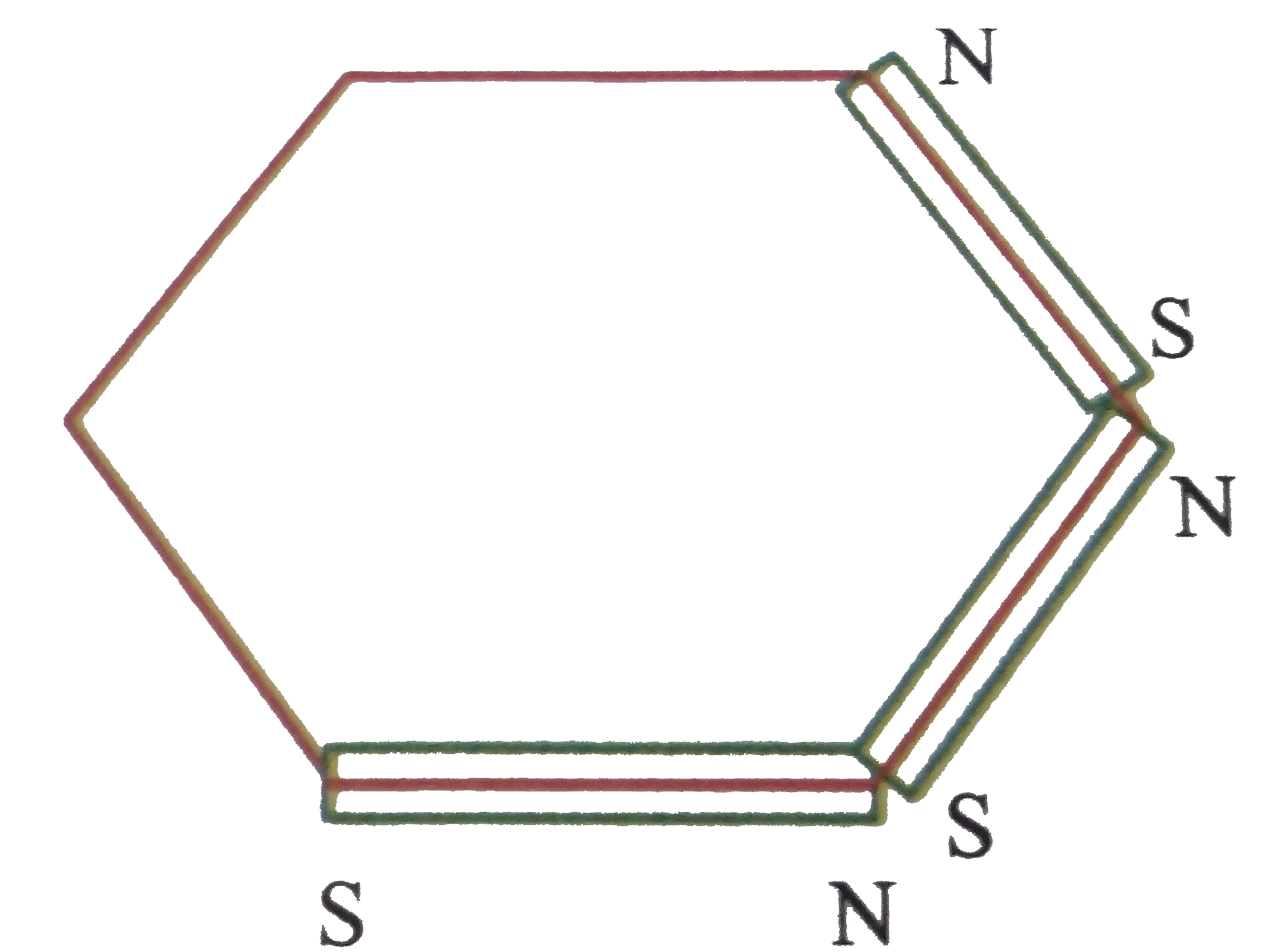In u−v method, we require the distance between object or image from the pole (vertex) of the mirror (actual distance). But practically we measure the distance between the indices A and B. (Observed distance). Which need not exactly co-inside with object and pole, there can be a slight mismatch called index error, which will be constant for every observation.

Index error=Observed distance-Actual distance(Just like zero error in screw guage, it is the excess reading).
To determine index error, mirror and object needle and placed at arbitary position. For measuring actual distance, a knitting needle is just fitted between the pole of mirror and object needle O. The length of knitting needle will give the actual object distance while the seperation between indices A and B at that instant is the observed distance.
So index error is-
e=Observed distance-Actual distance
= Separation between indices A and B- Length of knitting neddle once we get e, in
every observation, we get
Actual distance=Observed distance (separation between the indices)- Excess reading(e) There is an another term, Index corraction which is invert of index error.
Index correction=-index error
To find index error for u, when a knitting needle of length 20.0cm is adjusted between pole and object needle, the sepertion between the indices of object needle and mirror was observed to be 20.2cm. Index corraction for u is
−0.2cm
0.2cm
−0.1cm
0.1cm
The correct Answer is:B
Index error(excess reading)=Observed reading-Actual reading
=20.2−20.0=0.2cm
Topper's Solved these Questions
- EXPERIMENTAL PHYSICSBook:NARAYNAChapter:EXPERIMENTAL PHYSICSExercise:Asserson and Reason
Explore 4 Videos
- EXPERIMENTAL PHYSICSBook:NARAYNAChapter:EXPERIMENTAL PHYSICSExercise:Subjective type
Explore 6 Videos
- EXPERIMENTAL PHYSICSBook:NARAYNAChapter:EXPERIMENTAL PHYSICSExercise:Multiple answer
Explore 6 Videos
- ELECTROSTATICS AND GAUSS LAWBook:NARAYNAChapter:ELECTROSTATICS AND GAUSS LAWExercise:Intergers type question
Explore 11 Videos
- MAGNETISMBook:NARAYNAChapter:MAGNETISMExercise:LEVEL-II (H.W)
Explore 24 Videos
Similar Questions
Assertion (A): Least count of all screw based instruments is same.
Reason (R ): Least count for all screw based instruments are found using the ratio of pitch per division of circular scale.
View SolutionA screw gauge having 100 equal division and a pitch of length 1mm is used to measue the diameter of a wire of length 5.6cm. The main scale reading is 1mmand47th circular division coincides with the scale. Find the curved surface area of wire in cm2 to appropriate significant fihure.
(useπ=227
View SolutionWhile finding specific heat capacity using calorimeter, error might occur due to:
View Solutiona unifrom surface charge density 8σ exists over the entire x−y plane except for a circular hole of radius of a point p(0,0,√3) on the z-axis is found to be 2√xσε0 ,Find the value of x.
View SolutionThree identical thin bar magnets each of moment M are placed along three adjacent sides of a regular hexagon as shown in figure. The resultant magnetic moment of the system is

View SolutionTo find index error e distance between object needle and poler of the concave mirror is 20cm. The separation between the indices of object needle and mirror was observed to be 20.2cm in some observation, the observed image distance is 20.2cm and the object distance is 30.2cm find
(a) the index error e.
(b) focal length of the mirror f.
View SolutionIn u-v method, we require the distance between object or image from the pole (vertex) of the mirror (actual distance). But practically we measure the distance between the indices A and B . (Observed distance). Which need not exactly co-inside with object and pole, there can be a slight mismatch called index error, which will be constant for every observation. Index error=Observed distance-Actual distance(Just like zero error in screw guage, it is the excess reading). To determine index error, mirror and object needle and placed at arbitary position. For measuring actual distance, a knitting needle is just fitted between the pole of mirror and object needle O . The length of knitting needle will give the actual object distance while the seperation between indices A and B at that instant is the observed distance. So index error is- e= Observed distance-Actual distance = Separation between indices A and B - Length of knitting neddle once we get e , in every observation, we get Actual distance=Observed distance (separation between the indices)- Excess reading(e) There is an another term, Index corraction which is invert of index error. Index correction=-index error To find index error for v , when the same knitting needle is adjusted between the pole and the image needle, the separation between the indices of image needle and mirror was found to be 19.9cm . Index error for v is
View SolutionIn u-v method, we require the distance between object or image from the pole (vertex) of the mirror (actual distance). But practically we measure the distance between the indices A and B . (Observed distance). Which need not exactly co-inside with object and pole, there can be a slight mismatch called index error, which will be constant for every observation. Index error=Observed distance-Actual distance(Just like zero error in screw guage, it is the excess reading). To determine index error, mirror and object needle and placed at arbitary position. For measuring actual distance, a knitting needle is just fitted between the pole of mirror and object needle O . The length of knitting needle will give the actual object distance while the seperation between indices A and B at that instant is the observed distance. So index error is- e= Observed distance-Actual distance = Separation between indices A and B - Length of knitting neddle once we get e , in every observation, we get Actual distance=Observed distance (separation between the indices)- Excess reading(e) There is an another term, Index corraction which is invert of index error. Index correction=-index error In some observation, the observed object distance (Separation between indices of object needle and mirror) is 30.2cm , and the observed image distance is 19.9cm . Using index correction from previous two equations, estimate the focal distance of the concave mirror!
View SolutionIf u represents object distance from pole of spherical mirror and V represents image distance from pole of mirror and f is the focal length of the mirror, then a straight line u=v will cut u versus v graph at
View Solutionकिसी गोलीय दर्पण के लिए वस्तु की दूरी u, प्रतिबिम्ब की दूरी v तथा फोकस दूरी f में सम्बन्ध दर्शाने वाले समीकरण को _____ कहते हैं।
View Solutionदर्पण से प्रतिबिम्ब या वस्तु की दूरी सदैव ध्रुव से नापी जाती है।
View SolutionIn case of a curved mirror if the distance of object "(u)" and image "(v)" are measured from the pole and a graph is plotted between "(1/u) and "(1/v)" ,the graph is
View SolutionCalculate focal length of a spherical mirror from the following observation: object distance u=(10±0.1)cm and image distance v=(10±0.1)cm.
View Solutionएक ध्रुव से x cm की दूरी पर स्थित एक अवतल दर्पण के सामने रखी वस्तु का वास्तविक प्रतिबिम्ब 3 गुना आवर्धित होता है | यदि उसे (x + 5) cm की दूरी पर रखा जाए तो प्रतिबिम्ब का आवर्धन 2 गुना रह जायेगा | तब दर्पण की फोकस दूरी होगी
View SolutionThe minimum distance between an object and its actual image in front of a concave mirror will be: -
View Solution

